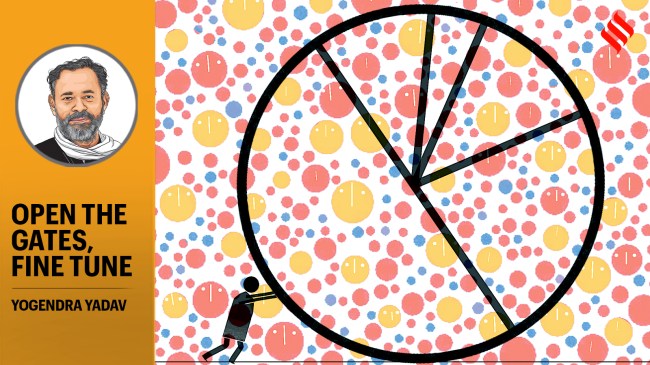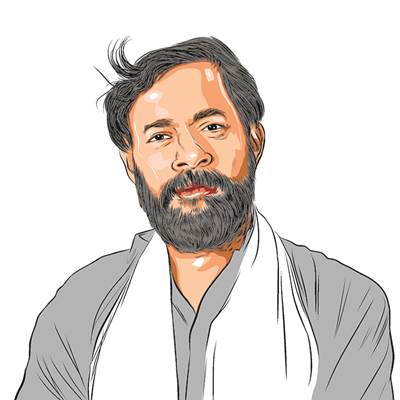Opinion Yogendra Yadav writes: Caste census announcement is an opportunity to fine-tune reservation policy
Once the debate shifts to the real issue of how, the first task would be to be vigilant about three matters
 Assuming that it shows significant disparities in resources and opportunities across caste groups and across different ‘jatis’ within these groups, the existing reservation policy must be fine-tuned. (Illustration by C R Sasikumar)
Assuming that it shows significant disparities in resources and opportunities across caste groups and across different ‘jatis’ within these groups, the existing reservation policy must be fine-tuned. (Illustration by C R Sasikumar) The announcement of the caste census signals a new phase in the policies and politics of social justice. As the dust kicked by the government’s dramatic announcement settles down, new contours should emerge in the debates on caste. Now that the supreme leader has changed his tune, the smokescreen of lies, half-truths and alibis that have distorted this straightforward idea should wane away. A three-decade-long absurdity of providing legal protection to OBCs without counting them would come to an end. The conversation now shifts from why caste census to when, how and what next. Debates on affirmative action will never be the same again.
The ongoing discussion on the motives of the Narendra Modi government should not detain us too long. It is a political decision, as most major decisions — good or bad — by governments in electoral democracies are. This is a pre-emptive move by the Prime Minister, who saw Rahul Gandhi’s pitch for the caste census as a long-term threat to the BJP’s large but vulnerable non-savarna vote base. Nor should we pay much attention to the blame game started by Ashwini Vaishnaw, holding Congress responsible for stalling the caste census. The move has already boomeranged. If anything, the “original sin” of burying the proposal for a caste census was committed by the Vajpayee government in 2000. If the Congress-led government was responsible for detaching caste count from the Census in 2011, the BJP government was responsible for suppressing the data of the Socio-Economic Caste Census.
Similarly, the dispute over credit will also soon fade away. For those who are historically minded, the principal credit goes to the social justice movement, specifically, to Rammanohar Lohia, or to its persistent advocates like Karpoori Thakur or Madhu Limaye, or to Sharad Yadav, who made the caste census his life’s mission. To the policy minded, the credit for making this idea viable should go to the previous RJD-JDU Bihar government and the present Telangana government. At the same time, for the politically minded, the credit would go to Rahul Gandhi. The history of social justice movements and state-level precedents would not have yielded anything if he had not made the caste census his personal mission and pushed Congress to make the issue its flagship demand. As the Leader of Opposition, this is undoubtedly his first major policy victory.
Once the debate shifts to the real issue of how, the first task would be to be vigilant about three matters, so that the caste census happens quickly, and as per the announcement. One, the sabotage of 2011 alerts us to guard against bureaucratic machinations: Caste enumeration must happen as an integral part of the next Census, not as a parallel exercise. Two, caste enumeration should have full, and not partial, coverage. It must not be limited to the “reserved categories” — SC, ST and now OBCs. Each of the castes under the “general” category must also be enumerated so that we can uncover the full profile of caste privileges. Three, there must be no attempt to tie the Census to the National Population Register, or any such trick that might derail the whole exercise.
The more serious demand should be to expand the scope of the Census to do a comprehensive caste-wise profile of resources and opportunities. So far, the Census has captured some basic data for every person (age, gender, education, occupation) and some data for every household (house type, basic amenities and a few assets) besides language, religion and caste category. The announcement of caste enumeration would mean that the Census will record the exact jati of each person (not just of SC and ST, as has been the case so far).
Yet, the Census does not record some key data necessary for a socio-economic and educational profile of each caste — ownership of land, ownership of economic enterprise, government job, profession, etc. Fortunately, all these questions were asked in the Socio-Economic and Caste Census (SECC) held in 2011. The Census Household Schedule should now be modified and all these key variables from SECC should now form a part of the new Census.
This will still leave the issue of mapping tiny but critical islands of high-worth resources and key positions in the most happening sites that cannot be captured by any Census — ownership and directorship of high-worth companies or commercial enterprises, high-level government jobs, top jobs in the private sector, admissions to the top higher educational institutions and positions of political leadership. That would require supplementary data collection to create a national caste-wise inventory of assets, facilities, resources, opportunities and positions. It would also require inserting the caste question into several other census-like data collection exercises, most of which already ask a question on broad caste category. These include the Indian Economic Census, the Agricultural Census, the All India Survey on Higher Education, the Household Consumer Expenditure Survey and Periodic Labour Force Survey by NSSO and the list of directors of registered companies, besides a survey of all public sector employees and all elected political representatives.
The final step would be improving the existing architecture of affirmative action. The caste census is only a diagnostic exercise. It is of no use if the data is not used to treat the disease. Caste census data should settle the debate on the rationale for the 10 per cent EWS quota. Besides, this may require some jatis to be excluded and others to be included in the list of OBCs.
Caste census data should also help in making informed decisions about whether a sub-quota is needed for some castes or communities from within SC, ST and OBCs. The judiciary has always demanded evidence-based formulation of reservation policies. The caste census should provide the gold standard of evidence.
Besides such fine-tuning, the caste census can open the gates for two major policy shifts. Assuming that it shows significant disparities in resources and opportunities across caste groups and across different jatis within these groups, the existing reservation policy must be fine-tuned. This would almost certainly indicate an enhancement in the 27 per cent quota for OBCs since their population is likely to be upwards of 45 per cent. That would require going beyond the 50 per cent ceiling set by the apex court for all reservation policies, although the same court ignored this in the case of EWS reservation.
Also, assuming that the mapping shows ever-greater disparities in the private sector, there would be a demand for extending affirmative action to private sector jobs, universities and colleges. Now that the BJP claims to be more pro-social justice than anyone else, it has to respond to the question posed by Congress: Is the government ready to do away with the 50 per cent ceiling on reservation, to extend affirmative action to the private sector and to apply existing legal provisions for reservation in the private universities and colleges?
For nearly two decades, policies and politics of social justice were at a dead end. The social justice movement has suffered from stagnation, fragmentation, subversion, defensiveness and has lived in denial of the challenges from within. The announcement of the caste census is an opportunity to begin afresh by expanding the scope of affirmative action beyond the public sector, widening the instruments beyond reservation and fine-tuning the criteria beyond a one-dimensional focus on caste.
The writer is member, Swaraj India, and national convenor of Bharat Jodo Abhiyaan. Views are personal




